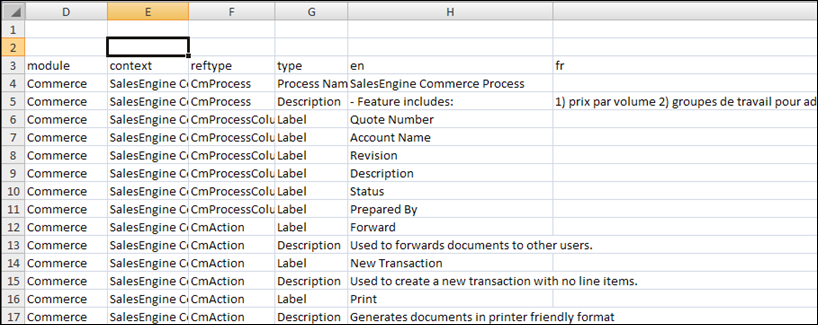Localization
Overview
Oracle CPQ helps you prepare your application for an international roll-out by allowing you to manage all of your translations through Bulk Upload and Download. From here, you can download all commerce and configuration translations in CSV format, have someone translate it, and finally re-upload it to CPQ. You will be able to filter by language and Oracle CPQ module (currently Commerce or Configuration).
Administration
The typical use case will be to download the translation file(s) first.
 Downloading Translations
Downloading Translations
-
 Navigate to the Download Categories List page.
Navigate to the Download Categories List page.
- Click Admin to go to the Admin Home Page.
-
Click Download under Bulk Data Services in the Utilities section.
The Download Categories List page opens.
-
Select the Translations radio button and click Next.
The Search Criteria page opens.
Continue with Step 5 if you do not need to filter your results based on language or Oracle CPQ module.
-
Select the Language you would like to download from the Language drop-down.

-
Select an Oracle CPQ module(s) from the drop-down.
The selections include: Commerce, Configuration, Part and Part Extended [Descriptions], Part Associations, Part Custom Fields, Serial Number, Serial Number Custom Fields and Price Books.

- Click Download.
-
Click the Translation file from the Download Status window.

- Unzip (or Save and then Unzip) the file.
-
Double-click the CSV file to open it.
Rename and save your file before making any changes.
-
Translate your content.
There are columns for the module, a contextual aid to assist the translator (so they know how it should be translated), the element being translated (is it a label, description, and so on), as well as what needs to be translated.
Example of Commerce:

Example of Configuration:

| update |
Update |
The action that will be performed when you bulk upload the translated file. Do not modify this field. |
| refid |
Reference ID |
The unique ID that Oracle CPQ generates for each item it stores. This could be a rule, attribute, Commerce Process, and so on. Do not modify this field. |
| fieldno |
Field Number |
Another ID that Oracle CPQ generates for each item it stores. Do not modify this field. |
| module |
Oracle CPQ Module |
Which module of the application the terms apply to.
For example: commerce, configuration, parts, and so on. Do not modify this field.
|
| context |
Context |
A navigation path to let you know where the term is being used.
For example: All Product Family > Amo la Pizza di Chicago > Size > Small.
Do not modify this field.
|
| reftype |
Reference Type |
What is being referenced within CPQ. For example: process columns, commerce actions, commerce attributes, product family, configuration attribute, and so on. Do not modify this field. |
| type |
Type |
What type of content you are translating. It could be a label, description, default data, menu item text, and so on. Do not modify this field. |
| en |
English Terms |
The English terms that need to be translated. Do not modify this field. |
| fr, esp, and so on |
Translated Terms |
Any terms that have already been translated in the selected language. This is where you add or update your translations. |
Example: fr
| add |
5106911 |
0 |
Configuration |
All Product Family > Amo la Pizza di Chicago |
PrdFamily |
Label |
Amo la Pizza di Chicago |
Amo la Pizza di Chicago |
| add |
5106963 |
0 |
Configuration |
All Product Family > Amo la Pizza di Chicago > Size |
ConfigAttr |
Name |
Size |
|
| add |
5106963 |
2 |
Configuration |
All Product Family > Amo la Pizza di Chicago > Small |
MenuItem |
Menu Item Text |
Small |
Petit |
 Using Japanese & Chinese Characters
Using Japanese & Chinese Characters
Users should have the East Asian Languages Fonts installed on their laptops or computers to see a predictable behavior with these steps or when working with characters of these languages in Excel, notepad or a browser.
Even if a font appears in a browser, it does not mean that the fonts are installed.
- Go to Control Panel.
- Open Regional and Language Options.
- Go to the Languages Tab.
-
Verify that Installed Files for East Asian Languages is checked.
If not, talk to IT Ops to get it installed before proceeding.
- Open Excel (not the .CSV file).
- Go to the Data Tab.
- In the Get External Data section in the toolbar, choose from text and select the translation file.
- On the first wizard screen, select the File Origin menu value to be UTF-8.
- After going through the Wizard file, the data will show correctly.
- Go to File > Excel Options.
- Select Advanced on the left-side panel.
- Click Web Options.
- Go to the encoding tab.
- Select 'Save this document as "UTF-8"'.
Notes
Translations will not affect table data. This functionality allows you to upload translations for all the data that has been customized in the application (attributes, attribute values, rules, and so on).
These standard upload actions are not available: add, modify, delete, and delete all.
Translations available for download are only content that has been created by a FullAccess user. This includes the product hierarchy, configuration attributes, Commerce Processes, Commerce actions, and so on.
Configuration and/or Commerce must be deployed to see changes.
Related Topics
 See Also
See Also
![]() Using Japanese & Chinese Characters
Using Japanese & Chinese Characters










